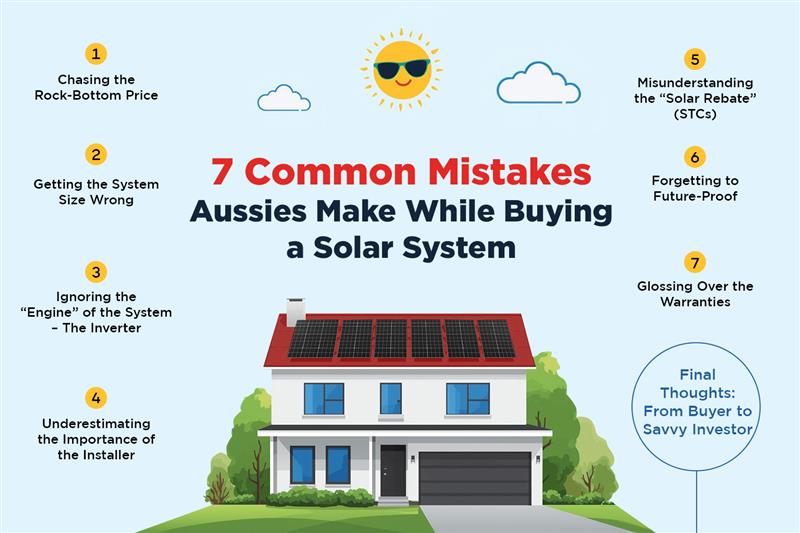Australia is blessed with abundant sunshine, making solar power one of the smartest financial decisions a homeowner can make. Slashing your power bills, reducing your carbon footprint, and increasing your property value – what’s not to love it for a lifetime?
However, the path to solar savings is paved with potential pitfalls. The market is flooded with different offers, making it easy for first-time buyers to make costly mistakes.
Common Solar Buying Mistakes in Australia
Thinking of going solar in Australia? It’s a fantastic move, but don’t get caught out! From chasing impossibly cheap deals to choosing the wrong-sized system, common mistakes can cost you thousands. Before you sign on the dotted line, learn about the critical errors many Aussies make and how you can easily avoid them to ensure your solar journey is a success.
The decision to invest in a residential solar power system in Australia is a significant financial undertaking. While the long-term benefits are well-established, the purchasing process presents several complexities that can lead to suboptimal outcomes.
This presentation will provide a detailed overview of the most frequent mistakes made by Australian consumers when buying solar. We will cover critical areas such as equipment selection, system sizing, installer vetting, and understanding federal incentives, equipping you with the essential knowledge to make a well-informed and valuable investment.
As an Aussie homeowner, you’re not just buying solar panels; you’re investing in a solar power station for your roof that needs to perform reliably for the next 25+ years.
To ensure your journey into solar is a sunny success, here are the seven most common mistakes Australians make and how you can avoid them.
7 Costly Mistakes Australians Do When Buying Solar?
Mistake 1: Chasing the Rock-Bottom Price
We’ve all seen them: ads for a full 6.6kW solar system for an unbelievably low price. While tempting, this is the most common and dangerous trap. In the solar industry, the old adage “you get what you pay for” has never been more true.
- The Problem: Ultra-cheap systems are cheap for a reason. Corners are cut somewhere, and it’s usually in one of three areas:
- Low-Quality Components: Unbranded, Tier 2 or Tier 3 panels with questionable long-term performance and reliability.
- A Cheap, Unreliable Inverter: The inverter is the “brains” of your solar system. A cheap one is the most likely component to fail, often just outside its short warranty period, leaving you with a hefty replacement bill.
- Sub-par Installation: The installer might use inexperienced subcontractors (“subbie roulette”), rush the job, or use poor quality mounting gear, leading to roof leaks or electrical hazards.
- What to do instead: Focus on value, not just price. Get at least three quotes from reputable, local installers. Ask them to break down the costs, specifying the brand and model of the panels and the inverter. A slightly higher upfront cost for quality components and a professional installation will pay for itself many times over in reliability, performance, and peace of mind.
Mistake 2: Getting the System Size Wrong
Choosing the right system size is a Goldilocks scenario – it needs to be “just right.”
- The Problem:
- Too Small: A small system might have an attractive price tag, but if it doesn’t generate enough power to offset your daytime usage, your savings will be disappointing. You’ll still be drawing significant energy from the grid at peak prices.
- Too Large: With feed-in tariffs (the amount your energy retailer pays you for exported electricity) being quite low across Australia, oversized systems are no longer a guaranteed money-maker. Over-investing in a system that exports huge amounts of power for a few cents per kilowatt-hour (kWh) can unnecessarily extend your payback period.
- What to do instead: Analyse your electricity bill. Find your average daily usage in kWh. A good installer will use this information, along with your electricity consumption patterns (i.e., when you use the most power), to recommend an appropriately sized system. The goal for most households today is to maximise self-consumption, using the solar power you generate in real-time. A standard 6.6kW solar system is a popular starting point for the average Aussie home, but a proper analysis is key.
Mistake 3: Ignoring the “Engine” of the System – The Inverter
Many people focus all their attention on the solar panels because they’re the most visible part of the system. This is like buying a car based only on its paint job while ignoring the engine.
- The Problem: The inverter does the hard work of converting the Direct Current (DC) electricity from your panels into the Alternating Current (AC) electricity your home uses. It’s a complex piece of electronics that operates for hours every day. A low-quality inverter will be inefficient, prone to failure, and could cripple your entire system’s output.
- What to do instead: Insist on a quality inverter from a reputable brand with a strong Australian presence for warranty support. Brands like Fronius, SMA, SolarEdge, and Enphase have a proven track record. Ask about the warranty – a standard inverter warranty is 5 years, but many quality brands offer a 10-year warranty as standard or as a paid upgrade. It’s often worth the extra investment.
Mistake 4: Underestimating the Importance of the Installer
You can have the best panels and inverter in the world, but a poor installation can ruin everything.
- The Problem: A dodgy installation can lead to a host of issues, from underperformance and roof leaks to serious electrical and fire safety hazards. High-pressure sales companies often subcontract the installation to the cheapest available team, with little oversight on quality or safety standards.
- What to do instead: Vet your installer thoroughly.
- CEC Accreditation: Ensure the company uses a Clean Energy Council (CEC) Accredited Installer and Designer. This is a non-negotiable minimum standard.
- Check Reviews: Look for genuine, detailed reviews on independent sites like Google, SolarQuotes, or ProductReview.
- Ask for References: A good local company will be proud to show you examples of their previous work.
- Workmanship Warranty: Ask about their workmanship warranty, which covers defects in the installation itself. A minimum of 5 years is standard, with 10 years being a sign of a confident and quality installer.
Mistake 5: Misunderstanding the “Solar Rebate” (STCs)
The federal government incentive is a major factor in making solar affordable, but it’s widely misunderstood.
- The Problem: Many people think the “soar rebate” is a cash-back payment they apply for after the installation. This isn’t how it works. The incentive is delivered through Small-scale Technology Certificates (STCs).
- How it really works: The number of STCs your system is eligible for depends on its size and your location. Your solar installer claims these certificates on your behalf and applies their value as a point-of-sale discount. The price you are quoted is almost always the final price after this discount has been applied. There’s no further money to claim back from the government. Be wary of any salesperson who is vague about this, as it’s a common tactic to make the deal seem better than it is.
Mistake 6: Glossing Over the Warranties
A solar system comes with multiple warranties, and the details matter.
- The Problem: People see “25-Year Warranty” and assume everything is covered. In reality, there are distinct warranties for different parts, and who backs them is critical.
- Panel Performance Warranty (25-30 years): Guarantees the panels will still produce a certain percentage (e.g., 80%) of their rated power after 25 years.
- Panel Product Warranty (10-25 years): This is the more important one. It covers defects in materials and manufacturing. A 15-25 year product warranty is a sign of a quality panel.
- Inverter Warranty (5-10 years): As mentioned, this is crucial.
- Workmanship Warranty (5-10 years): From your installer, covering the installation itself.
- What to do instead: Ask for the specific warranty details for each component. Crucially, check if the manufacturer has an office and support team based in Australia. A lifetime warranty from a company with no local presence is practically worthless if you need to ship a faulty panel back overseas.
Mistake 7: Forgetting to Future-Proof
Your energy needs are not static. A system that’s perfect for you today might not be in five years.
- The Problem: Homeowners buy a system that only meets their current needs, without considering future changes. This can lead to needing an expensive upgrade or a second system down the line.
- What to do instead: Think ahead. Are you planning on:
- Buying an electric vehicle (EV) in the next 5-10 years?
- Installing a pool or a spa?
- Adding a battery for energy storage?
- Having more family members move in?
If the answer to any of these is yes, discuss it with your installer. They might recommend a slightly larger system or, more importantly, a hybrid (or “battery-ready”) inverter. This will make adding a battery in the future a simple and cost-effective process.
Your Sunny Future Awaits for a Reliable Solar Power System in Australia
Investing in solar is one of the best decisions you can make for your home and your wallet. By avoiding these seven common mistakes, you move from being just a consumer to a savvy investor.
Do your research, prioritise quality and value over the lowest price, and partner with a reputable local installer. That way, you can be confident your solar power system will be reliably saving you money for decades to come. Happy savings!
Final Thoughts: From Buyer to Savvy Investor
Ultimately, buying solar is one of the most rewarding home improvements an Australian can make. The key is to approach it as a long-term investment, not a simple purchase.
By steering clear of the “too good to be true” deals, focusing on quality components, and choosing a trustworthy installer, you’re not just buying solar panels, you’re securing your energy independence. Do your homework, ask the right questions, and get ready to enjoy the substantial savings and benefits for years to come.





